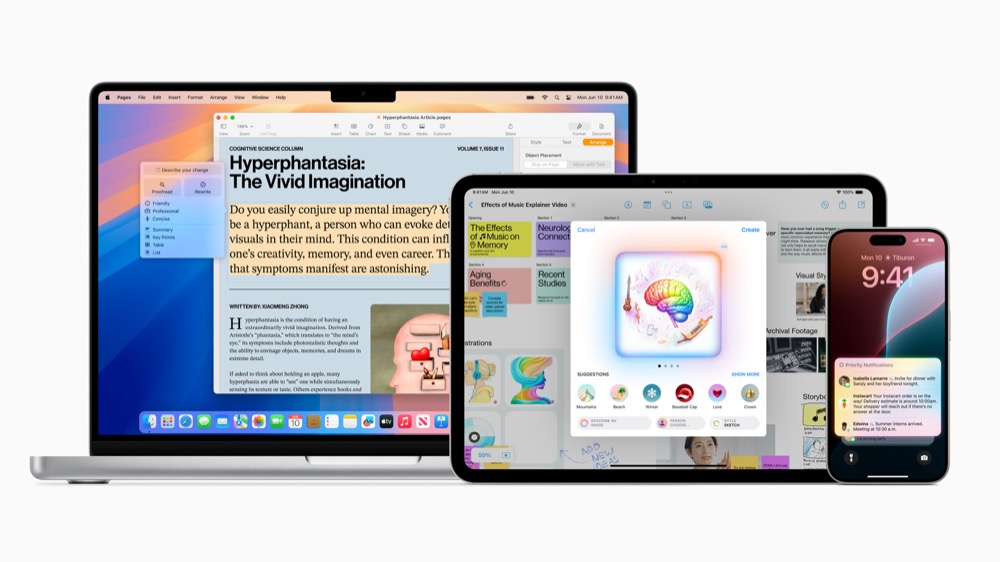WWDC: Apple announces Apple Intelligence

Apple did as we expected with the introduction of Apple Intelligence. It’s a new AI that understands personal context to deliver intelligence that is helpful and relevant, while also maintaining your privacy.
Context and privacy
Available across iPhone, iPad, and Mac, Apple Intelligence combines Apple’s own GenAI with the private and personal data held on your device. That means it can use your information, privately, to figure out useful ways to help you get things done. It harnesses the power of Apple silicon to understand and create language and images, take action across apps, and draw from personal context to simplify and accelerate everyday tasks.
Apple also introduced Private Cloud Compute, which sets a new standard for privacy in AI, with the ability to flex and scale computational capacity between on-device processing and larger, server-based models that run on dedicated Apple silicon servers.
What Apple said
“We’re thrilled to introduce a new chapter in Apple innovation. Apple Intelligence will transform what users can do with our products — and what our products can do for our users,” said Tim Cook, Apple’s CEO.
“Our unique approach combines generative AI with a user’s personal context to deliver truly helpful intelligence. And it can access that information in a completely private and secure way to help users do the things that matter most to them. This is AI as only Apple can deliver it, and we can’t wait for users to experience what it can do.”
So, what features can we expect?
Writing Tools can rewrite, proofread, and summarise text nearly everywhere they write, including Mail, Notes, Pages, and third-party apps. Apple Intelligence allows users to choose from different versions of what they have written, adjust the tone to suit the audience and task at hand.
In Mail, Priority Messages, a new section at the top of the inbox shows the most urgent emails, like a same-day dinner invitation or boarding pass. Across a user’s inbox, instead of previewing the first few lines of each email, you can see summaries without needing to open a message. For long threads, users can view pertinent details with just a tap. Smart Reply provides suggestions for a quick responses, and will identify questions in an email to ensure everything is answered.
Priority Notifications appear at the top of the stack to surface what’s most important.
In the Notes and Phone apps, users can now record, transcribe, and summarise audio. When a recording is initiated while on a call, participants are automatically notified, and once the call ends, Apple Intelligence generates a summary to help recall key points.
Image Playground powers image creation capabilities for self expression, helping create ad hoc images to spice up conversations. Taking emoji to an entirely new level, users can create an original Genmoji to express themselves. By simply typing a description, their Genmoji appears, along with additional options.
What about Photos?
language can be used to search for specific photos, such as “Maya skateboarding in a tie-dye shirt,” or “Katie with stickers on her face.” Search in videos also becomes more powerful with the ability to find specific moments in clips so users can go right to the relevant segment. Additionally, the new Clean Up tool can identify and remove distracting objects in the background of a photo — without accidentally altering the subject.
Memories lets users create the story they want to see by simply typing a description. Using language and image understanding, Apple Intelligence will pick out the best photos and videos based on the description, craft a storyline with chapters based on themes identified from the photos, and arrange them into a movie with its own narrative arc. Users will even get song suggestions to match their memory from Apple Music. As with all Apple Intelligence features, user photos and videos are kept private on device and are not shared with Apple or anyone else.
Siri gets a lot smarter
With richer language-understanding capabilities, Siri is more natural, more contextually relevant, and more personal, with the ability to simplify and accelerate everyday tasks. It can follow along if users stumble over words and maintain context from one request to the next.
Additionally, users can type to Siri, and switch between text and voice to communicate with Siri in whatever way feels right for the moment. Siri also has a brand-new design with an elegant glowing light that wraps around the edge of the screen when Siri is active.
Siri can now give users device support everywhere they go, and answer thousands of questions about how to do something on iPhone, iPad, and Mac. Users can learn everything from how to schedule an email in the Mail app, to how to switch from Light to Dark Mode.
With onscreen awareness, Siri will be able to understand and take action with users’ content in more apps over time. Siri can also take hundreds of new actions in and across Apple and third-party apps.
And privacy for all
Apple Intelligence relies on understanding deep personal context while also protecting user privacy. That means on-device processing, and many of the models that power it run entirely on device. To run more complex requests that require more processing power, Private Cloud Compute extends the privacy and security of Apple devices into the cloud to unlock even more intelligence.
With Private Cloud Compute, Apple Intelligence can flex and scale its computational capacity and draw on larger, server-based models for more complex requests. These models run on servers powered by Apple silicon, providing a foundation that allows Apple to ensure that data is never retained or exposed.Apple Intelligence with Private Cloud Compute sets a new standard for privacy in AI, unlocking intelligence users can trust.
And then there’s ChatGPT
Apple is integrating ChatGPT access into experiences within iOS 18, iPadOS 18, and macOS Sequoia, allowing users to access its expertise — as well as its image- and document-understanding capabilities — without needing to jump between tools. Users are asked before any questions are sent to ChatGPT, along with any documents or photos, and Siri then presents the answer directly. ChatGPT will also be available in Apple’s systemwide Writing Tools, which help users generate content for anything they are writing about. Privacy protections are built in for users who access ChatGPT — their IP addresses are obscured, and OpenAI won’t store requests. ChatGPT’s data-use policies apply for users who choose to connect their account.
ChatGPT will come to iOS 18, iPadOS 18, and macOS Sequoia later this year, powered by GPT-4o. Users can access it for free without creating an account, and ChatGPT subscribers can connect their accounts and access paid features right from these experiences.
Apple Intelligence is free for users, and will be available in beta as part of iOS 18, iPadOS 18, and macOS Sequoia this autumn in U.S. English. Some features, software platforms, and additional languages will come over the course of the next year.
Please follow me on Mastodon, or join me in the AppleHolic’s bar & grill and Apple Discussions groups on MeWe.



